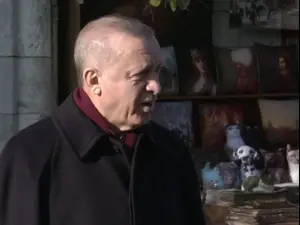news
News in Israel
Events in Israel
NIS 150 billion and one prophecy by Herzl: The numbers behind the Gush Dan metro
Three lines, 40 meters underground, 149 km of tunnels and 450 million trips a year. The approval of the plans is in the last line, and before the war of excavations between the government ministries began, we dived into the numbers that create the largest project in Israeli history.
Tags
Gush Dan Metro
Keenan Cohen
Saturday, 05 December 2020, 11:35
Share on Facebook
Share on WhatsApp
Share on general
Share on general
Share on Twitter
Share on Email
0 comments
The bill to dissolve the Knesset passed a preliminary reading ...
Macron and Erdogan in mutual accusations 05.12.2020
Kuwait's Foreign Minister welcomes agreement to end conflict with ...
Trump continues to claim that the results of the US presidential election ...
Documentation of the arrest of Ruth Zuckerman, demonstrating against the Prime Minister ...
Palestinian reports: A boy was shot dead in clashes with force ...
The UK has approved the use of the Pfizer vaccine for Corona ...
Libushur: "We are working for a quick return to full activity"
US Secretary of State Pompeo: "Iran is desperate to return ...
Locked gate, debris and without a tombstone - neglect in the grave of Rosh ...
The missile ship "Achi Magen" arrived in Israel, movement ...
USA: The House of Representatives approved the non-incrimination of ...
In the video: A representative of the Ministry of Transportation says that Minister Regev instructed to move forward with the metro project (Photo: Knesset Channel)
The data revealed in late November in the deliberations of the State Audit Committee is depressing.
A detailed presentation by the State Comptroller's Office presented the planning of public transportation, or rather - its complete absence - in its nakedness.
In 1997, the government adopted recommendations that had existed for years for the establishment of metropolitan transportation authorities.
Since then, in a decade of leaps and bounds, Israeli governments have been careful not to uphold and implement this decision.
Representatives of the Ministry of Transport do not take part in all the discussions in the district committees, do not attend the labor discussions in the early stages of the plans, do not participate in the discussions of the local planning and building committees and therefore the ministry does not express its public transport policy.
We all suffer from the consequences of this abandonment, in the density of vehicles per kilometer of road, which is much higher than in other OECD countries, from slow and low-volume public transport, air pollution, loss of working hours, road accidents and more.
All this is intended to clarify how incomprehensible What is the story of the metro project that is being planned in the Gush Dan metropolitan area? The plan has since been entrusted to the Planning and Building Commission and is now in the final stages of approving the plans, recognizing the important numbers behind the largest transport project in the country's history.
More on Walla!
NEWS
Bar Ilan opposes the metro route planned to pass under the campus: "Research damage"
To the full article
More on Walla!
NEWS
Four times more than in Tel Aviv: the peak of reports of cell phone use while driving
Imaging of the metro train integrated in the mass transit system (Photo: Urban transportation routes)
One ancient sin.
More than any other issue, traffic congestion, the huge traffic jam between the Hadera-Gedera borders is the biggest cornerstone of transportation in Israel.
The result of the years of neglect of public transportation, a certificate of poverty for planning institutions, the state's addiction to the 40 billion shekels that the car industry puts into it every year, the fever of the attached car, and yes, also the character of the Israeli who is in love with his car.
What "many countries in the world have cracked we" discover "only now - an integrated public transport system for mass transit is the only solution.
Three metro lines.
The metro will consist of three lines that get the names M1, M3 and M3 also get colors blue, green and red respectively, will inherit the entire coverage range of the light rail.
When the blue line runs south-north from Rehovot to Raanana, the green line from the heart of Tel Aviv and east to Rosh HaAyin, the red line actually produces a "rainbow" that surrounds Tel Aviv and connects the south and north of the city with the eastern part of Gush Dan.
More on Walla!
NEWS
Despite her opposition, Regev instructed "to advance with all her might" the planning of the metro project
To the full article
Metro routes in the Gush Dan metropolitan area (Photo: Urban transportation routes)
Four logistics centers.
This vast array of subways will be served by centers known in professional parlance as "depot".
These are expected to be built in Rishon Lezion, in the Sgula industrial area in Petah Tikva, south of the Mesubim junction and in Kfar Saba.
These are large complexes of tens of dunams each, which will be used for storage and care of carriages.
The problem is that every city wants the metro service, but those who need to host these complexes - an integral part of the infrastructure - do not necessarily want it in their backyard.
The municipalities of Kfar Saba and Hod Hasharon, for example, claim that NTA (urban transportation data) made a change in plans without sharing them and will build the depot within tens of meters of the residents' homes. There is also a plan to erect these complexes indoors in part, and to allow construction on top of each of them as part of the revenue model from the project.
Ten virtual sessions.
In July, during the preparation of the submission of the plans, NATA held a series of virtual Facebook meetings in the form of transmitters with residents of the authorities where the metro is expected to pass. Still, among the mayors of Raanana, Kfar Saba, Hod Hasharon and Ramat Gan , information is missing and uncertainty regarding the route of the metro and the impact on them.
24 authorities.
metro rail will cross the block urban metropolis Dan and it mainly means a lot of coordination between the representatives unions of those authorities. are to make sure things are consistent engineering standpoint and the aspect of understanding the needs of residents In Nata, there are no less than 270 meetings held with authorities and municipalities, but as mentioned, at least for some of them, such as Ramat Gan, with 170,000 residents, which receives only two stations, the manner in which the decisions were made is not clear at all.
Imaging of one of the Gush Dan metro stations (Photo: Urban transportation routes)
40 meters below the ground.
The depth at which the tunnels are dug will allow relatively easy access to the stations themselves which will not be too deep underground.
For comparison, the Navon train station in Jerusalem is 80 meters deep.
This depth will allow trains to move without any effect of noise or vibration on the ground core.
However, on the other hand, landowners who are on the railway route will probably avoid the possibility of building "in depth" mainly in the aspect of multi-storey underground car parks.
While logic says that in the area of the railway route will be saved anyway a large amount of cars, and yet, the parties in the matter, as in the matter of expropriations, we will still see rolling for many years in the courts.
40 km / h on average.
If in your average car speed in a city like Tel Aviv is close to 10 km / h, the average speed of high-speed urban trains like the light rail in Jerusalem and also the one that is expected to get up in Tel Aviv can reach 20 km / h but stands at About 15 km / h on average in practice, due to its proximity to vehicular and pedestrian traffic and the intersection between them and them.
The metro is expected to move at a much higher speed - 40 km / h on average, including stops at stations. This means more efficient and faster arrival from station to station and much faster pick-up rounds. The numbers talked about at the airport are trains every 3-6 minutes Once every 90 seconds during peak hours.
109 stations.
No less than 109 stations are expected to be built on the route of the three metro lines, about a kilometer apart.
These will be included in every stop line at major hotspots.
Partial list: on line M1 Meir Hospital, Tel Aviv University, Weizmann Institute, Meir Hospital, Kaplan and Yitzhak Shamir (Assaf Harofe), Tzrifin and more. On line M2 Carmel Market, Habima, Kirya, Wolfson Hospital, Bar Ilan University and line M3 Among others, the industrial areas of Herzliya, Ramat Hachayal, Kiryat Arie, Tel Hashomer Hospital and Ben Gurion Airport.
The excavators train to dig the subway in Tel Aviv, 2016 (Photo: Reuven Castro)
149 km of tunnels.
This is the overall length of the metro lines in their current design. The M1 line will be the longest of the three with 85 km with 62 stations.
The second line in length will be M3 with 39 km and 24 stations along it and the M2 line, although with only 26 km, but with a density of 22 stations along it.
NIS 150 billion.
And the account is not final.
At the beginning of the project, the amount was NIS 50 billion, but as the planning work became more complicated, and as the state understood the scope of expropriations and compensation for this project, the amount swelled.
It currently stands at NIS 150 billion, an amount that the French company Sister, which evaluates such projects, has provided.
The Ministry of Transportation says that the budget will be NIS 200 billion.
According to the metro model, between a third and a half of the amount will come from improving the value of the land and taxing the building rights in it, and the rest will come from the state coffers.
According to a study by Prof. Yoram Shiften of the Technion and Dr. Nir, most of the direct economic benefits of the metro to the economy are expected to be NIS 23-34 billion a year. NIS 550 billion - so the return on investment is expected to be in a few years.
450 million passengers. The
metro will be the largest mass transportation system in Israel and this is the annual number of passengers according to Nata's forecasts, when the three lines will be operated at full capacity.
Each metro train consists of eight carriages and can accommodate an average of about 1,300 passengers. These are huge numbers, far beyond any means of transportation or route that can be reached.
Just for comparison, a lane on the road transports between 600 and 1,600 people per hour, a light rail about 7,500 in the metro and the number is 25,000 passengers per hour.
2032 is the target year.
But do not buy a ticket yet.
The question of the million dollars, or 200 billion shekels, is when we can actually buy a ticket and enter the Israeli metro.
Well here the story really gets complicated.
Somewhere in 2018 the estimates of the Ministry of Transportation stood at 6 years, at the end of that year NTA has already recalibrated the clock to 2030. Today it declares 2032 or 2035 for initial operation and 2040 for full operation, so according to this invoice series, The experience with the light rail numbers could be as well as 2045 and possibly beyond.Any such delay and duration of work, has tremendous implications for the same refund from metro operations and this too should be taken into account as a catalyst in the implementation of the project.
Herzl Katz corner
With the entry of Israel Katz into the Ministry of Finance, the infrastructure department was established, and he is the one who actually has authority over the metro project, the idea behind this move was simple, a combination of the people on the tap and the people familiar with the project This one, and yes, also wants to be signed to his success.
Benjamin Ze'ev Herzl, who this year marks exactly 160 years since his birth, wrote in his book "Altneild" as early as 1902 about the utopia in the Jewish state with descriptions of its glorious mass transit systems.
In the first translation of the book into Hebrew by Nahum Sokolov, the translator called it "Tel Aviv".
Tel Aviv today may be very far from Herzl's vision of an efficient and functional public transportation system, but we have been waiting for this moment for so many years, so there is still hope.
If you want no fairy tale.
Share on Facebook
Share on WhatsApp
Share on general
Share on general
Share on Twitter
Share on Email
0 comments















